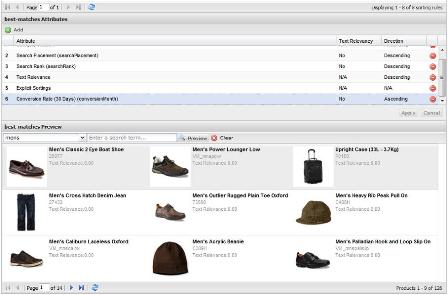Demandware eCommerce Platform Winter '10
Metrics-Driven Merchandising and a Comprehensive Sample Store Strengthen an Attractive SaaS Ecommerce Platform
Demandware eCommerce is the ecommerce software platform offering of Demandware, Inc., a privately held, Woburn, MA-based software supplier and ecommerce hoster that was founded in 2004. Winter ’10 is the current, semiannual release of the platform that was introduced in 2004. To date, Demandware claims that approximately 100 customer brands, mostly retailers in the U.S. and Europe, have deployed ecommerce sites based on Demandware eCommerce. If you are a company that generates between $20 million and $500 million in online revenues in the retail, consumer brand manufacturing, and media and entertainment industry segments, then Demandware eCommerce could be your ideal ecommerce platform.
NETTING IT OUT
Demandware eCommerce Platforms is the ecommerce software platform offering of Demandware, Inc., a privately held, Woburn, MA-based software supplier and ecommerce hoster that was founded in 2004. Winter ’10 is the current, semiannual release of the platform that was introduced in 2005. To date, Demandware claims Demandware eCommerce has been deployed for 100 customer brands, mostly retailers in North America and Europe.
On the Customers.com report card for evaluating B2C ecommerce platforms, Demandware eCommerce exceeds requirements in merchandising and analytic functionality. It needs improvement in support for assisted-service channels. The platform meets requirements for all other evaluation criteria.
If you are a company that generates between $20 million and $500 million in online revenues in the retail, consumer brand manufacturing, and media and entertainment industry segments, then Demandware eCommerce could be your ideal ecommerce platform. It offers rich packaged services, configurable and customizable data and content, and a comprehensive and completely reusable sample store with hosted multi-tenant deployment. These are the ingredients for easy and fast ecommerce deployment.
Specifying Sorting Rules

© 2010 Demandware, Inc.
Illustration 5. This illustration shows the Business Manager workspace for specifying sorting rules.
DEMANDWARE ECOMMERCE
Product Introduction and Background
Demandware eCommerce Platform is the ecommerce platform offering of Demandware, Inc., a privately held firm founded in 2004 based in Woburn, MA.
Demandware offers the Demandware eCommerce Platform through subscription licenses for on-demand deployment. (Note that while Demandware uses the term “on-demand,” we would describe the deployment of Demandware eCommerce stores as hosted multi-tenant.) The platform’s current release is Winter ’10 within a semi-annual release cycle. Since its introduction in 2005, approximately 100 brands, mostly online retailers in North America and Europe, have deployed their ecommerce sites on the Demandware eCommerce Platform.
What’s New in Demandware Winter ’10?
We last evaluated Demandware Fall ’08 in November 2008. Since that time, Demandware Summer ’09 and Demandware Winter ’10 have been released. Both new releases add significant new capabilities to the product. In Table A, we list the new features in Demandware Summer ’09, and in Table B, we list the new features of Demandware Winter ’10. Following the Tables, we’ll describe and discuss the most significant of the new features in each release. Note that Demandware groups the new features into merchandising, search and navigation, catalog and content management, development platform, and site management.
New Features in Demandware Winter ’10
(Please download the PDF to see the table.)
Table A. In this table, we list the new features in Demandware Winter ’10.
Winter ’10 makes solid improvements in all areas. Here are those that we think are most significant.
Merchandising improvements are mostly improvements to the Business Manager toolset that makes it easier for merchandisers to manage merchandising resources. Two of the improvements take advantage of price books. Price books give merchandisers an alternative pricing mechanism to embedding prices in product data. A price book contains price definitions for a group of products for a currency. Price books may be nested. A child price book inherits the price definitions from the price book that it is “based on” and may override any of the inherited price definitions. The new feature “multiple price entries per price book” lets merchandisers create multiple price definitions for the products in a price book based on specific time periods, source codes, or customer groups. The “fixed-priced product promotions with price book” lets merchandisers implement fixed price discounts through price definitions within price books as an alternative to using promotions. Good flexibility in these new features.
Search and navigation improvements give merchandisers a lot more control over search processing and search results management. Demandware uses its own search engine. These new features improve it to where it begins to approach what we’ve been calling premium search. We’ll examine these features in detail when we evaluate search.
In site management, “shipping method restriction to specified locations” lets merchandisers control the relationships between shipping methods and geographies. For example, they can specify that the ground shipping method cannot be used for Hawaii or Nantucket. “Payment methods” gives merchandisers control over restriction, application, and promotional use of payment methods. In previous releases, this control had to be exercised through custom scripting.
The mobile storefront is our favorite by far. It will be your favorite, too...
Sign in to download the full article
0 comments
Be the first one to comment.



